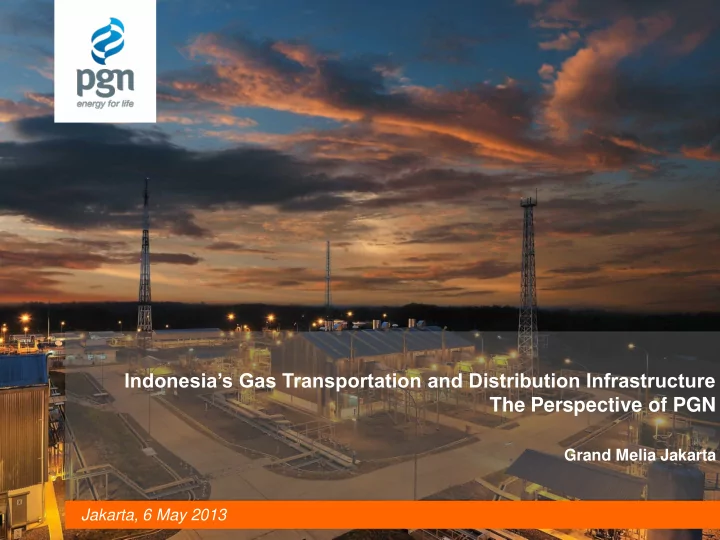

Indonesia’s Gas Transportation and Distribution Infrastructure The Perspective of PGN Grand Melia Jakarta Jakarta, 6 May 2013
Introduction • PT Perusahaan Gas Negara (Persero) Tbk (PGN) is an Indonesian SOE in natural gas transmission and distribution business. Established in 1965. • PGN operates and owns more than 5900 Km pipelines, for gas transmission and distribution. • Distribution areas are including northern part of Sumatera, Batam, South Sumatera, West and East Java island. PGN is one of the key players in providing natural gas for Indonesia Gas Market PT Perusahaan Gas Negara (Persero), Tbk 2
Introduction PGN as Transporter and Distributor of Natural Gas 5/6/2013 PT Perusahaan Gas Negara (Persero), Tbk 3
Introduction PGN Infrastructures & Customers Dur Panaran Station i KALIMANTAN Pagardewa Compressor St. Grissik Receiving Station Labuhan Maringgai St. Legend: Strategic Business Unit (SBU) I Strategic Business Unit (SBU) II Strategic Business Unit (SBU) III South Sumatera – West Java Transmission Pipeline (SSWJ) (970 MMSCFD) Grissik – Duri transmission pipeline (427 MMSCFD) Grissik – Singapore transmission pipeline (465 MMSCFD) Pagardewa Station Terbanggi Besar St. Muara Bekasi Station Bojonegara Station PT Perusahaan Gas Negara (Persero), Tbk 4
Introduction PGN Subsidiaries & Affiliates PT Perusahaan Gas Negara (Persero), Tbk 5
Indonesian Gas Market Rapid Indonesia Energy Demand Growth The rapid growth of natural gas demand due to: No Subsidy of Fuel for the Industries Subsidies for industries revoked in 2005 Pricing and Efficiencies Significant price and efficiencies benefit by converting to natural gas, as well as environmental concerns Conversion of Power Plants Pent-up demand from the conversion of existing dual fired power plants pending availability of gas Demand from the industries Require natural gas to compete in the era of Free Trade Agreement (Ref: SKK Migas, 2013) PT Perusahaan Gas Negara (Persero), Tbk 6
Indonesian Gas Market Indonesia Natural Gas Allocation - 2012 Domestic Domestic LNG LPG Indonesia Gas Contract 2002 - 2012 3% 8% Citygas Oil Lifting 0% Total : 7181 BBTUD 10% Export Fertilizer 3550 BBTUD 19% (49%) Domestic Industry 33% Domestic Electricity 27% 3631 BBTUD (51%) • Tendency to increase domestic utilization • Shifting Paradigm in managing Indonesia Export natural Gas (Ref. SKK Migas, 2013) PT Perusahaan Gas Negara (Persero), Tbk 7
Indonesian Gas Market Infrastructure Development Challenges Infrastructure Gap to Increase Domestic Utilization Source : Ministry of Energy & Mineral Resources Decree No. 2700.K/11/MEM/2012 PT Perusahaan Gas Negara (Persero), Tbk 8
Indonesian Gas Market Infrastructure Development Challenges 2013 2014 2015 2016 2017 2018 2019 2020 2021 Courtesy: MEMR • Geographical challenges • Time synchronization challenges • Pricing Gap between domestic and export challenges PT Perusahaan Gas Negara (Persero), Tbk 9
Indonesian Gas Market Indonesia Natural Gas Business Structure Model 3 Model 1 Model 2 Model 4 Open Access & Wholesales Vertical Integrated Competition in Production Unbundling & Retail Competition Competition Canada USA India Mexico iran Current France * UK Business State Argentina Current Pakistan Regulation Demand Indonesia Australia Venezuela Germany Finland Brazil Thailand Rusia Malaysia Italy Denmark China Spain Korea Swedia Holland Japan Ref: The emergence in the natural gas industries (Juris, 1998) AT Kearney (2009) PT Perusahaan Gas Negara (Persero), Tbk 10
Lesson Learnt From US Gas Business • US has an integrated gas infrastructure • Infrastructure has integrated markets and form single national market • Pricing through common references (Henry Hub) • Onshore / On land geographical challenges • Indonesia has a discrete gas market • No single national market • Infrastructure was developed based on ‘B to B’ scheme • Onshore and large Offshore geographical challenges PT Perusahaan Gas Negara (Persero), Tbk 11
Lesson Learnt From US Gas Business Creating Single Indonesia Gas Market (Virtual of Physical Integration) Western Market ACEH (NAD) Eastern Market 5.74 NATUNA NORTH SUMATRA 1.28 51.46 CENTRAL SUMATRA 8.56 18.33 PAPUA EAST BORNEO SOUTH SUMATRA 4.23 24.32 17.90 CELEBES WEST JAVA 3.70 6.40 MOLUCCAS 15.22 EAST JAVA (Advance Resources Interational, Inc., 2003 processed) • Eastern part: LNG Vessel Shale Gas Potential CBM Reserves = 453.30 TCF Gas Reservs = 334.5 TSCF Transportation Mode Integration (As of December 31st 2010) LNG RT PGN (existing & Future) • Western PROVEN = 104.71 TSCF part: Pipeline system POTENTIAL = 48.18 TSCF Future LNG Plant Integration TOTAL = 152.89 TSCF Existing LNG Plant (As of January 1st, 2011) PT Perusahaan Gas Negara (Persero), Tbk 12
Lesson Learnt From US Gas Business Indonesia Energy Security US Energy Security definition is No Import and Self sustaining country Indonesia • Fulfillment of domestic demand • Control the export PT Perusahaan Gas Negara (Persero), Tbk 13
Conclusion a. PGN has been proven in Indonesia as a gas company successfully developing and integrating gas infrastructure and gas market in many parts in the western Indonesia. b. Indonesia is in the state of rapid development and thus requiring natural gas as its major role. c. The challenge is providing the adequate infrastructure to increase the domestic gas utilization; • Gap in Infrastructure availability; • Complicated gas business transformation. d. The challenges in infrastructure development: • Geographical challenges • Synchronization between Production Planning and Market Readiness PT Perusahaan Gas Negara (Persero), Tbk 14
Thank you
Recommend
More recommend